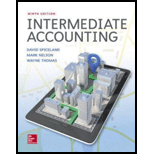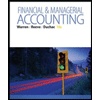
Calculating activity and profitability ratios
• LO4–10
Financial statements for Askew Industries for 2018 are shown below (in thousands):
2018 Income Statement
| Sales | $9,000 |
| Cost of goods sold | (6,300) |
| Gross profit | 2,700 |
| Operating expenses | (2,000) |
| Interest expense | (200) |
| Tax expense | (200) |
| Net income | $ 300 |
Comparative
| Dec. 31 | ||
| 2018 | 2017 | |
| Assets | ||
| Cash | $ 600 | $ 500 |
| 600 | 400 | |
| Inventory | 800 | 600 |
| Property, plant, and equipment (net) | 2,000 | 2,100 |
| $4,000 | $3,600 | |
| Liabilities and Shareholders’ Equity | ||
| Current liabilities | $1,100 | $ 850 |
| Bonds payable | 1,400 | 1,400 |
| Paid-in capital | 600 | 600 |
| 900 | 750 | |
| $4,000 | $3,600 |
Required:
Calculate the following ratios for 2018.
- 1. Inventory turnover ratio
- 2. Average days in inventory
- 3. Receivables turnover ratio
- 4. Average collection period
- 5. Asset turnover ratio
- 6. Profit margin on sales
- 7. Return on assets
- 8. Return on shareholders’ equity
- 9. Equity multiplier
- 10. Return on shareholders’ equity (using the DuPont framework)
(1)
Activity ratios:
It measures the capacity of a company to use its asset, liability and capital accounts to generate revenue in the form of cash.
Profitability ratios:
It measures the companies efficiency of operations and performance that generates profit
For the company
To calculate: Inventory turnover ratio of A Incorporation for the year 2018.
Explanation of Solution
Calculate the inventory turnover ratio of A Incorporation for the year 2018
Working note:
Explanation:
Inventory turnover ratio is used to determine the number of times inventory used (or) sold during the particular accounting period.
Hence, the inventory turnover ratio of A Incorporation is 9.0 Times for the year 2018.
(2)
To calculate: Average days in inventory of A Incorporation for the year 2018.
Explanation of Solution
Calculate the average days in inventory of A Incorporation for the year 2018
Working note:
On the Average A Incorporation takes 40 days to convert inventory into sales in the operation cycle.
Hence, the average days in inventory for A Incorporation for the year 2018 is 40.56 Days
(3)
To calculate: Receivables turnover ratio of A Incorporation for the year 2018
Explanation of Solution
Calculate the receivables turnover ratio of A Incorporation for the year ended 2018
Working note:
Receivables turnover ratio indicates how quickly a company is able to collect its accounts receivable.
Hence, the Receivables turnover ratio of A Incorporation is 18 Times for the year 2018
(4)
To calculate: Average collection period of A Incorporation for the year 2018
Explanation of Solution
Calculate the Average collection period of A Incorporation for the year 2018
Working note:
On the average it takes 20.28 days for A Incorporation to collect receivables from its customers.
Hence the, Average collection period of A Incorporation for the year 2018 is 20.28 Days for the year 2018.
(5)
To calculate: Asset turnover ratio of A Incorporation for the year 2018
Explanation of Solution
Calculate the Asset turnover ratio of A Incorporation for the year 2018
Working note:
1. Calculate the total assets:
Total assets turnover ratio indicates that A Incorporation has generated $2.37 in sales for every $1.00 of assets.
Hence, the Asset turnover ratio of A Incorporation is $2.37 for the year ended 2018.
(6)
To calculate: Profit margin on sales of A Incorporation for the year ended 2018
Explanation of Solution
Calculate the profit margin on sales of A Incorporation for the year ended 2018
Profit margin on sales of A Incorporation has Net income of $0.033 for every $1.00 of Total revenue earned.
Hence, the Profit margin on sales of A Incorporation is 3.33% for the year 2018
(7)
To calculate: Return on assets of A Incorporation for the year ended 2018.
Explanation of Solution
Calculate the Return on assets of A Incorporation for the year ended 2018
Working note:
Calculate the total assets
7.89% of profit is earned by A Incorporation in relation to its total assets for the year ended 2018.
Hence, the rate of return of A Incorporation is 7.89% for the year ended 2018.
(8)
To calculate: Return on shareholders’ equity of A Incorporation for the year ended 2018
Explanation of Solution
Calculate the return on shareholders’ equity of A Incorporation for the year ended 2018
Working notes:
1. Calculate the total shareholders’ equity at the beginning and total shareholders’ equity at the ending
|
Details |
year | year |
| 2018 | 2017 | |
| Paid in capital | $600 | $600 |
| Retained earning | $900 | $750 |
| Total | $1,500 | $1,350 |
Table (1)
2. Calculate the total equity
Rate of return on shareholders’ equity reveals the profit that the company generates with the money shareholders’ have invested.
Hence, the rate of return of shareholders’ equity of A Incorporation for the year ended 2018 is 21.1%
(9)
To Calculate: Equity multiplier of A Incorporation for the year 2018
Explanation of Solution
Calculate the Equity multiplier of A Incorporation for the year 2018
Working note:
1. Calculate total assets
2. Calculate the total shareholders’ equity at the beginning and total shareholders’ equity at the ending
| Details | year | year |
| 2018 | 2017 | |
| Paid in capital | $600 | $600 |
| Retained earning | $900 | $750 |
| Total | $1,500 | $1,350 |
Table (2)
3. Calculate total shareholders’ equity
Equity multiplier is the financial leverage ratio that measures the total asset of the company to its total shareholders’ equity. If the ratio is higher than the company uses more of debt financing than equity.
Hence, the equity multiplier of A Incorporation is 2.67 for the year ended 2018.
(10)
To Calculate: Return on shareholders’ equity (using the DuPont framework) for the year
2018.
Explanation of Solution
Calculate the Return on shareholders’ equity (using the DuPont framework) for the
Year 2018
DuPont framework of measuring Return on shareholders’ equity states that
The company’s Return on equity can be measured by the product of three ratios namely;
1. Profit margin on sales
2. Asset turnover ratio
3. Equity multiplier
Hence, the Return on shareholders’ equity of A Incorporation for the year
2018 is 21.1%.
Want to see more full solutions like this?
Chapter 4 Solutions
Intermediate Accounting
 Fundamentals of Financial Management (MindTap Cou...FinanceISBN:9781337395250Author:Eugene F. Brigham, Joel F. HoustonPublisher:Cengage Learning
Fundamentals of Financial Management (MindTap Cou...FinanceISBN:9781337395250Author:Eugene F. Brigham, Joel F. HoustonPublisher:Cengage Learning Cornerstones of Financial AccountingAccountingISBN:9781337690881Author:Jay Rich, Jeff JonesPublisher:Cengage Learning
Cornerstones of Financial AccountingAccountingISBN:9781337690881Author:Jay Rich, Jeff JonesPublisher:Cengage Learning Financial & Managerial AccountingAccountingISBN:9781285866307Author:Carl Warren, James M. Reeve, Jonathan DuchacPublisher:Cengage Learning
Financial & Managerial AccountingAccountingISBN:9781285866307Author:Carl Warren, James M. Reeve, Jonathan DuchacPublisher:Cengage Learning Survey of Accounting (Accounting I)AccountingISBN:9781305961883Author:Carl WarrenPublisher:Cengage Learning
Survey of Accounting (Accounting I)AccountingISBN:9781305961883Author:Carl WarrenPublisher:Cengage Learning




